The International Genetically Engineered Machine Competition (iGEM) aims to creatively solve global problems (e.g. sustainable food) using synthetic biology. Synthetic biology consists of molecular biology, organic chemistry, engineering, nanobiotechnology and information technology. The goal is to implement synthetic biology with its areas at the RUB in order to breed innovation and implement a starting point for the following iGEM teams. Through this program, the connection between industry, society, and science is strengthened.
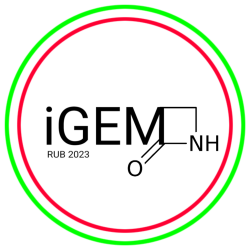
The Motivation
Antibiotic residues in wastewater are a major health and environmental issue (1).
The treatment of wastewater is not efficient enough to remove antibiotics complete. These antibiotic residues in the environment promote the development of resistance in bacterial strains (2). Antibiotic-resistant bacteria have a negative public health impact because treating infections caused by resistant bacteria is difficult and costly. We want to prevent antibiotics from entering the environment!
1: Phoon, Bao Lee, et al. "Conventional and emerging technologies for removal of antibiotics from wastewater." Journal of hazardous materials 400 (2020): 122961.
2: Karthikeyan, K. G., and Michael T. Meyer. "Occurrence of antibiotics in wastewater treatment facilities in Wisconsin, USA." Science of the total environment 361.1-3 (2006): 196-207.
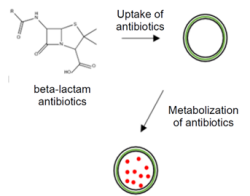
The Project
Our goal is to construct a biosensor for beta- lactam antibiotics that uses a fluorescent protein to indicate the presence of antibiotics, degrades them, and signals successful degradation with another fluorescent protein.
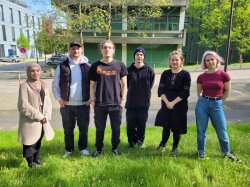
The Team
We are students of biology and biochemistry in the master’s programme of the Ruhr-Universität-Bochum.
For more information, sponsoring opportunities and general questions please contact us at:
Follow us on Instagram and Twitter
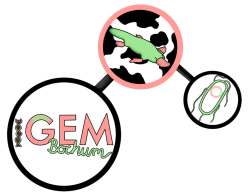
Our project
Livestock farming, especially dairy and meat production, contribute to a large extent to CO2 emissions and thus to climate change. Nowadays more and more people are questioning their diet, with the goal of climate protection in the back of their minds. Wouldn't it be perfect if, in the future, milk proteins could be produced without exploiting animals? This is exactly the question we are currently working with and through that, we aim to produce vegan dairy products that are identical in structure to those of the animal equivalents. We use genetically modified organisms (GMOs) for production, specifically bacteria and fungi. The aim is to use these microbes to produce yoghurt with different flavors, for example, vanilla. The genetic basis stemming from the cow and the platypus.
The milk produced indirectly by the mushrooms would offer an equivalent substitute for those people who do not necessarily want to switch to plant-based milk, but still want to combat against global warming and animal exploitation. A natural product can be guaranteed, because although the milk proteins are produced by genetically modified mushrooms, the yoghurt will not contain any traces of GMOs. We want to hold this product to a high standard in regards to its yield, texture, and taste.
Implementation
For the production of the various components of milk, the genetic information for the individual proteins is required. This information is inserted into a plasmid and cloned in bacteria. The shuttle vectors are then transformed into the eukaryotic organism (fungus). Only the post-translational odifications of the fungus are able to ensure the correct production of our desired proteins. This is followed by the mass production of said proteins and the following production of flavors. The desired products are purified and processed into yoghurt with the final addition of sugar.
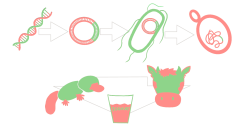
Extensive portraits of our project and team have also been published in BIOspektrum 06/2021 and TV (both in German).
If you have further questions or are interested in supporting us, you can contact us via email or on our Instagram and Twitter channels.